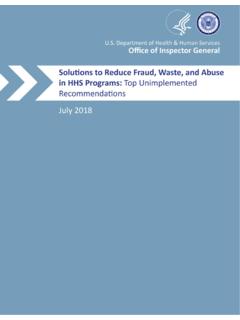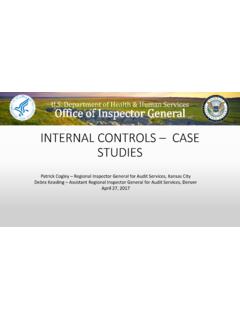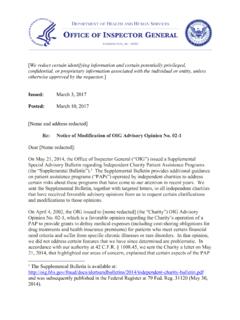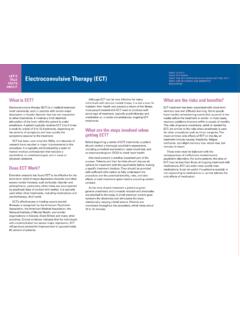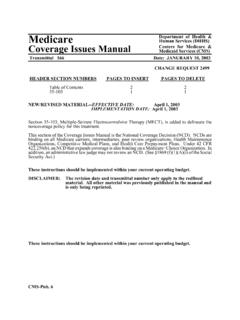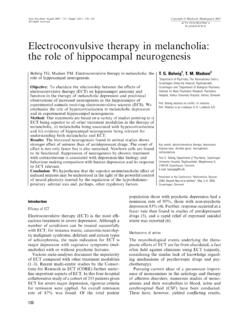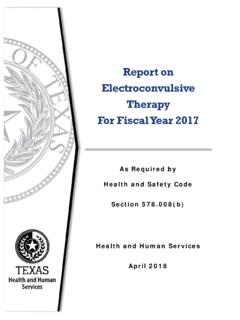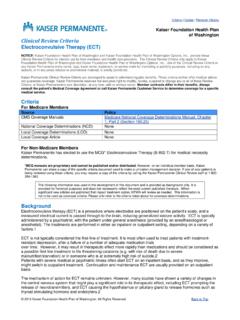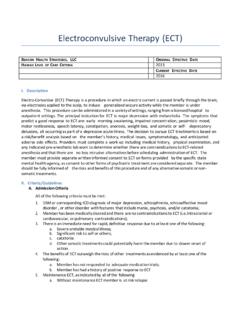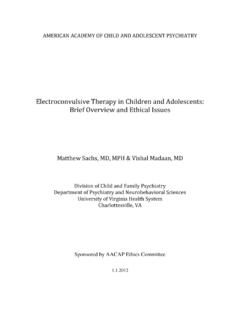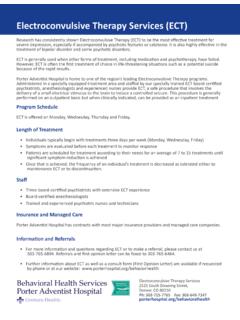Transcription of Department of Health and Human Services OFFICE OF ...
1 Department of Health and Human Services OFFICE OF INSPECTOR GENERAL JANET REHNQUIST Inspector General DECEMBER 2001 OEI-12-01-00450 Medicare Reimbursement for electroconvulsive therapy OFFICE OF INSPECTOR GENERAL The mission of the OFFICE of Inspector General (OIG) mandated by Public Law 95-452, as amended by Public Law 100-504, is to protect the integrity of the Department of Health and Human Services programs as well as the Health and welfare of beneficiaries served by them. This statutory mission is carried out through a nationwide program of audits, investigations, inspections, sanctions, and fraud alerts. The Inspector General informs the Secretary of program and management problems and recommends legislative, regulatory, and operational approaches to correct them.
2 OFFICE of Evaluation and Inspections The OFFICE of Evaluation and Inspections (OEI) is one of several components of the OFFICE of Inspector General. It conducts short-term management and program evaluations (called inspections) that focus on issues of concern to the Department , the Congress, and the public. The inspection reports provide findings and recommendations on the efficiency, vulnerability, and effectiveness of departmental programs. OEI's headquarters OFFICE prepared this report under the direction of Stuart Wright, Director, Medicare and Medicaid. Headquarters Alan Levine Senior Program Specialist To obtain copies of this report, please call our headquarters OFFICE at (202) 619-0480. Reports are also available on the World Wide Web at our home page address: Janet Rehnquist Inspector General OIG Final Report: Medicare Reimbursement for electroconvulsive therapy , OEI-12-01-00450 Thomas A.
3 Scully Administrator Centers for Medicare & Medicaid Services Purpose This memorandum recommends that the Centers for Medicare & Medicaid Services (CMS) consider the appropriateness of one of the two current procedural terminology (CPT) codes for electroconvulsive therapy (ECT). Currently, ECT can be billed under 90870, Single Seizure; or 90871, Multiple Seizures, per day. However, the National Institutes of Health (NIH) 1985 Consensus Conference Statement on ECT, as well as more current research, indicates that the administration of multiple seizures is not clinically recommended. Background electroconvulsive therapy is a treatment for severe mental illness in which a brief application of electric stimulus is used to produce a generalized seizure.
4 Electrodes connected to an ECT machine are attached to the scalp of a patient who has received general anesthesia and a muscle relaxant. The ECT treatments are generally given on an every-other-day basis for 2 to 3 weeks. Seizure lengths of duration of greater than 20 seconds per treatment (as assessed by motor activity, not electroencephalogram seizure activity) are considered adequate for therapeutic purposes. According to the NIH 1985 Consensus Development Conference Statement on ECT, ..The number of treatments in a course of therapy varies. Six to twelve treatments are usually The March 14, 2001, Journal of the American Medical Association states that ECT is ..an effective and safe treatment for severe major (it) may also be seriously considered as treatment for patients with acute mania, and for patients with schizophrenia who have not responded to adequate antipsychotic Medicare allowed charges for ECT in 1998, 1999, and 2000 were $ million; $ million; and $ million, respectively.
5 The total allowed Services were 154, 995 (1998); 153,193 (1999); and 153,000 (2000). Page 2 - Thomas A. Scully Issue -Medical Literature Does Not Support Use of CPT 90871 According to the American Medical Association s CPT Assistant newsletter, Summer 1992, two CPT codes are available for billing Medicare for ECT Services : Code 90870, single seizure, and Code 90871, multiple seizures, per day. (Note that multiple seizures is also known as multiple monitored ECT (MMECT)). Medicare allowed charges for CPT 90871 during 1998, 1999 and 2000 were $473,000; $464,513; and $435,000, respectively. The total allowed Services were 3,855 (1998); 3,788 (1999); and 3,585 (2000). The average allowed charge for CPT 90871 in 2000 was $ ; for CPT 90870 it was $ The NIH 1985 Consensus Development Conference Statement on ECT states that.
6 Multiple-monitored ECT (several seizures during a single treatment session) has not been demonstrated to be sufficiently effective to be Notwithstanding this statement, CPT 90871 is being reimbursed by Medicare, as noted above, at the rate of about $500,000 per year. In 1997, we sought an opinion from a carrier medical director, who is also a psychiatrist, about Medicare ECT data. He advised us as follows: ..the use of 90871, multiple seizures in one day, should show a very small technique of purposely inducing multiple seizures to increase the therapeutic benefit is rarely done, and is apparently only supported by anecdotal This carrier medical director believes that the frequent use of 90871 could be caused by practitioner confusion.
7 He states: ..in the ordinary course of administering ECT, or in order for the treatment to be effective, the seizure needs to last more than 20 seconds. If the seizure is of shorter duration, the seizure needs to be repeated until a seizure of sufficient duration is achieved. This should be coded as Because the NIH Consensus Development Conference Statement on ECT was issued over 15 years ago, we recently asked the National Institute of Mental Health (NIMH) for their opinion on the use of Code 90871 (MMECT). Page 3 - Thomas A. Scully In a May 14, 2001 memorandum, NIMH made the following points. In MMECT, the patient undergoes ECT in the usual fashion, but before gaining consciousness, undergoes another session of ECT designed to elicit a second (or additional) seizure.
8 There were three rationales for this: (a) as a more intense treatment, MMECT would induce a faster therapeutic response; (b) if MMECT resulted in fewer inductions of general anesthesia by "doubling up" treatments, it would be safer for medically compromised patients; and (c) lower cost based on fewer treatment sessions. The modern use of MMECT is centered on clinical case series, supplemented with limited single-blind studies, to emerge from Oregon between the mid-1960s and the mid-1980s. Administering between 4 and 8 seizures, spaced 3 minutes apart, per session, the studies reported an equivalent efficacy between MMECT and standard ECT, while claiming the above cited advantages of reduced cost, lessened time ill, and lower general cognitive disturbances associated with MMECT.
9 However, other investigators were unable to verify the claimed advantages, and reports of prolonged seizures and profound confusional states following MMECT turned the field away from MMECT. A key study was published (Comprehensive Psychiatry 1972; 13:115-121) that was definitive in showing none of the claimed benefits and many risks; the investigators concluded that MMECT was unacceptable. Recent objective reviews have concluded that MMECT should not be part of a routine clinical treatment. A 1999 book entitled Electroshock: Restoring the Mind notes from the present-day perspective that the presumed advantages of MMECT (see list above) have in fact not been realized; the book concluded that "such schedules are not encouraged today. The second edition (2000) of the American Psychiatric Association Task Force on ECT's recommendations for clinical training and practice, published in the last 6 months, finds a role for MMECT only "rarely," and even then for no more than two seizures, far below the 4 to 8 recommended by the advocates for MMECT.
10 There are accepted clinical grounds for inducing double seizures at a single session, including manic delirium and catatonia, where speed of clinical response is essential, and also in the case of an inadequate seizure resulting from a very high seizure threshold, where the patient is re-stimulated. However, according to NIMH ..This is not considered "MMECT," and there appears to be no reason to code this differently from regular The NIMH concluded that MMECT does not, in fact, have a scientifically demonstrated role and should not be done. Specifically, NIMH noted that ..MMECT, while attracting advocates among some clinicians over the years, has never entered mainstream medicine. Its role in modern psychiatric practice is marginal at the research supported and reviewed by NIMH does not provide evidence in favor of continuing a routine code for what is generally regarded as an outmoded procedure that should not be used in other than extraordinary circumstances.
